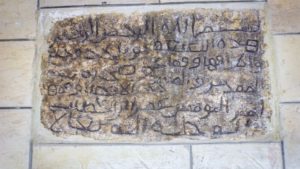by WorldTribune Staff, November 1, 2016
Many centuries before their denial of a Jewish connection to Jerusalem, Muslims carved an inscription into a mosque acknowledging the link.
The inscription from the Mosque of Umar in Nuba, a village nearly 26 kilometers (16 miles) southwest of Jerusalem, mentions the village as an endowment for the Dome of the Rock and Al-Aqsa Mosque, according to a report by The Times of Israel on Oct. 31. The inscription dated to the 9th or 10th centuries, the report said.

The Dome of the Rock is referred to in the Mosque of Umar text as “the rock of the Bayt al-Maqdis” — literally, “The Holy Temple” — “a verbatim translation of the Hebrew term for the Jerusalem temple that early Muslims employed to refer to Jerusalem as a whole, and the gold-domed shrine in particular,” the report said.
The limestone block into which the inscription was carved stands above the mosque’s mihrab, the niche pointing toward Mecca, and reads: “In the name of God the merciful, the compassionate, this territory, Nuba, and all its boundaries and its entire area, is an endowment to the Rock of Bayt al-Maqdis and the al-Aqsa Mosque, as it was dedicated by the Commander of the Faithful, Umar ibn al-Khattab for the glory of Allah.”
A recent resolution by UNESCO, the UN’s cultural agency, ignored Jewish and Christian ties to the Temple Mount and referred to the controversial holy site solely by its Muslim names, “Al-Aqsa Mosque/Al-Haram Al-Sharif,” and defined it only as “a Muslim holy site of worship.”
The distinction between the Al-Aqsa Mosque and Dome of the Rock in the mosque’s inscription, authors Assaf Avraham and Peretz Reuven wrote, “together with the Hadith tradition and [Arabic] literature praising Jerusalem [from the 11th century], leads us to posit that the term Bayt al-Maqdis as it appears in the Nuba inscription… alludes directly to the Dome of the Rock.”
Further, medieval Muslim traditions surrounding the Dome of the Rock cited by the authors “identified the mount again and again with David and Solomon’s temples” and “understood that the mount is the ancient temple rebuilt, the Quran is the true faith and the Muslims the true Children of Israel.”
The 10th-century Muslim historian Muḥammad ibn Aḥmad Shams al-Din al-Muqaddasi wrote in his description of Syria and Palestine that “in Jerusalem is the oratory of David and his gate; here are the wonders of Solomon and his cities,” and that the foundations of the Al-Aqsa Mosque “were laid by David.”
“In effect, the Muslims saw themselves as the ones continuing the biblical tradition of the temple,” Avraham explained; they considered themselves the “new Jews.”
In that vein, the Muslims built the third temple in the 7th century in the form of the Dome of the Rock.
For several centuries, until the fall of Jerusalem to crusading Christians in 1099, Muslims associated the Haram al-Sharif with the former temples, Andreas Kaplony wrote. After Jerusalem was conquered in 637, “their plan is to rebuild as a Muslim mosque the destroyed Temple,” he explained.
As late as 1951, historian — and then-Palestinian mayor of East Jerusalem — Aref el-Aref’s history of the Dome of the Rock stated unequivocally that “the ruins of Solomon’s Temple are under al-Aqsa” and that Umar built a mosque atop the former building’s site. But by 1965, “A Brief Guide to the Dome of the Rock and Haram al-Sharif,” published by the Supreme Awqaf Council, completely avoided mentioning the ancient Jewish temples.
